Perennial flowers are a must-have in your garden. They come back year after year, usually growing even stronger and more beautiful with age. However, unlike annuals, most perennials have a relatively short bloom season. To ensure plenty of flowers throughout the year, it’s important to plan your garden with plants by season to stagger bloom times.
Key Takeaways:
- Choose the best perennial flower varieties for your garden.
- Plan your garden to ensure continuous bloom throughout the seasons.
- Provide proper care and maintenance to keep your perennial flowers healthy.
- Consider incorporating early spring, summer-blooming, shade-loving, and fall-blooming perennials for a diverse and vibrant garden.
- Create a landscape design that maximizes visual appeal and optimal growth conditions for your perennial flowers.
Selecting the Best Perennial Flower Varieties
When planning your perennial flower garden, it’s essential to choose the right varieties. Consider factors such as color, bloom time, and growth habit to create a visually stunning landscape. With numerous perennial flower varieties available, ranging from vibrant and colorful to subtle and elegant, you can design a garden that reflects your personal taste and style.
“Choosing perennial flower varieties allows you to enjoy the beauty of these flowers for years to come.”
To add variety to your garden, you can find perennial flower seeds to grow your own plants. This not only offers more options but also allows you to witness the beauty of the entire growth process, from seed to blooming flower. Planting perennial flower seeds can be a rewarding and fulfilling experience.
When selecting the best perennial flower varieties for your garden, remember to choose a mix of different colors. By incorporating a range of hues, you can create a captivating display that catches the eye. Whether you prefer a vibrant burst of color or a more soothing and delicate palette, there are endless options to suit your preferences.
Key Considerations for Selecting Perennial Flower Varieties:
- Color: Choose a variety of colors to create visual interest and complement the surrounding landscape. From bold and vibrant blooms to soft pastels, each hue adds its own unique charm.
- Bloom Time: Consider the flowering season of each perennial variety to ensure continuous blooming throughout the year. Select plants that bloom at different times to enjoy a kaleidoscope of colors throughout the seasons.
- Growth Habit: Take into account the growth habit of perennial flowers to ensure they fit well within your garden design. Consider their height, spread, and overall shape to create a balanced and visually pleasing arrangement.
When it comes to selecting perennial flower varieties, the options are truly endless. Whether you opt for classic favorites like roses and peonies or explore unique and rare species, the key is to choose flowers that resonate with your personal style and preferences. Your garden will be a reflection of your own creativity and passion.
| Variety | Color | Bloom Time | Growth Habit |
|---|---|---|---|
| Rose | Various (red, pink, yellow, white) | Spring to fall | Upright shrub |
| Lavender | Purple | Summer | Mounded |
| Black-Eyed Susan | Yellow with black center | Summer to fall | Upright |
| Coneflower | Pink, purple, white | Summer to fall | Upright |
Incorporate these perennial flower varieties into your garden to enjoy their beauty and charm. Experiment with different combinations and create your own unique oasis of colors, scents, and textures.
Tips for Planting Perennial Flowers
When it comes to creating a stunning perennial flower garden, proper care and planning are essential. By following these tips, you can ensure your garden not only thrives but also becomes a beautiful landscape design that will be the envy of your neighbors.
Create a Landscape Design
Before starting your perennial flower garden, take the time to plan out your landscape design. Consider factors such as the amount of sunlight your garden receives, the type of soil you have, and the drainage in the area. These elements play a crucial role in the success of your perennial flowers.
For example, if you have a sunny garden, choose perennial flowers that thrive in full sunlight. On the other hand, if you have a shady corner, opt for shade-loving perennials that will brighten up the area. By selecting the right plants for each location, you’ll ensure optimal growth and visual appeal.
Provide Adequate Spacing
When planting perennial flowers, it’s important to provide adequate spacing between plants. This prevents overcrowding and ensures that each plant has room to grow and flourish. Consult the planting instructions for each variety to determine the recommended spacing.
Keep in mind that as perennials mature, they may spread and create a fuller garden. By giving them enough room to grow, you can avoid the need for frequent transplanting or overcrowded and unhealthy plants.
Follow Proper Planting Techniques
The success of your perennial flower garden starts with proper planting techniques. Begin by preparing the soil, ensuring it is loose and well-draining. This will provide a favorable environment for root development and healthy plant growth.
When planting, dig a hole slightly larger than the root ball of your perennial flower. Gently place the plant in the hole, making sure it sits at the same level as it did in its nursery container. Backfill the hole with soil and lightly press down to secure the plant in place.
After planting, water your perennial flowers thoroughly. This helps settle the soil and ensures that the roots receive the moisture they need to establish themselves. Add a layer of mulch around the base of the plants to help retain soil moisture and suppress weed growth.
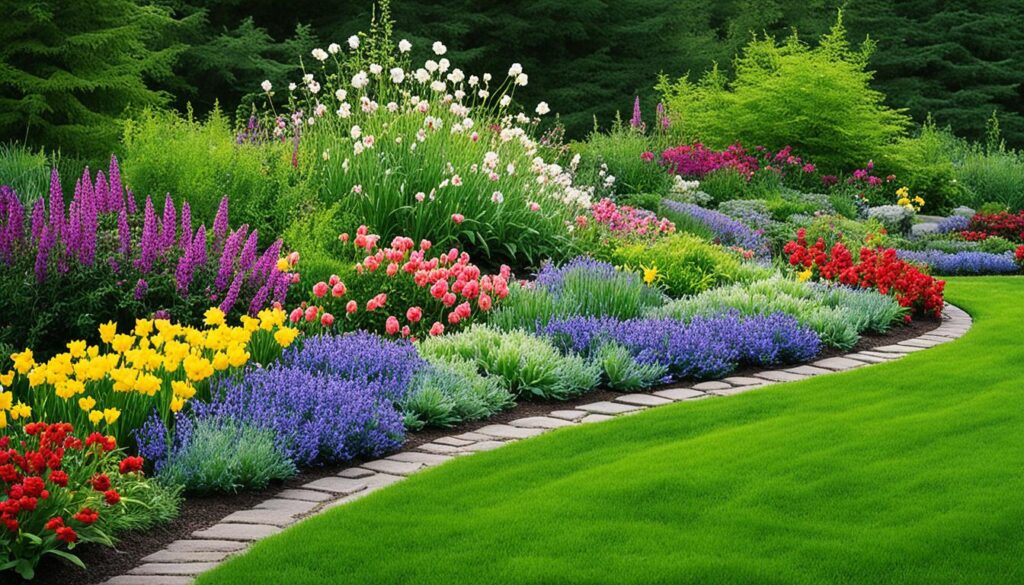
Maintaining Perennial Flowers for Year-Round Beauty
To ensure your perennial flowers stay healthy and beautiful all year, proper maintenance is crucial. By following a few key steps, you can keep your plants thriving and blooming for seasons to come.
- Regular Watering: Perennial flowers have specific watering needs, depending on the species and climate conditions. It’s important to water them deeply and consistently to promote healthy root growth. Check the soil moisture regularly, and water when the top inch feels dry. Avoid overwatering, as it can lead to root rot.
- Fertilizing: Providing adequate nutrients is essential for perennial flower care. Apply a balanced slow-release fertilizer in early spring, following the package instructions for the specific product. This will help fuel healthy growth and vibrant blooms. Avoid over-fertilizing, as it can result in excessive foliage growth and reduced flower production.
- Pruning: Regular pruning helps maintain the shape and health of perennial flowers. Remove any dead, damaged, or diseased plant parts as soon as you notice them. Prune back leggy growth to encourage bushier, more compact plants. It’s best to prune after the flowering season, but if necessary, you can deadhead spent blooms during the blooming season to promote continuous flowering.
- Mulching: Applying a layer of organic mulch around the base of your perennial flowers can provide numerous benefits. Mulch helps retain moisture in the soil, reducing the frequency of watering. It also helps suppress weed growth and protects the roots from temperature extremes. Apply a 2- to 3-inch layer of mulch, taking care to keep it away from the stems to prevent rot.
- Pest and Disease Control: Regularly inspect your perennial flowers for any signs of pests or diseases. Common pests include aphids, slugs, and snails. If you notice any signs of infestation, take appropriate action, such as using organic pest control methods or insecticidal soaps. Monitor for diseases like powdery mildew or leaf spots and treat them promptly to prevent spreading.
Incorporating these maintenance practices into your perennial flower care routine will help ensure your flowers stay in optimal health, maximizing their beauty and longevity.
| Maintenance Tips for Perennial Flowers | Benefits |
|---|---|
| Regular watering | Prevents drought stress and promotes healthy root growth |
| Fertilizing | Provides essential nutrients for vibrant blooms |
| Pruning | Maintains plant shape, removes dead or diseased parts, and encourages bushier growth |
| Mulching | Retains moisture, suppresses weeds, and protects roots |
| Pest and disease control | Prevents damage from pests and diseases, ensuring plant health |
Maintaining your perennial flowers with care will reward you with a garden that thrives all year long. Enjoy the beauty and splendor of your beloved flowers, knowing that your efforts in perennial flower maintenance have paid off.

Planning Your Perennial Flower Garden for Continuous Bloom
Achieving continuous bloom in your perennial flower garden requires careful planning. By selecting a combination of spring, summer, and fall-blooming perennials for both sunny and shady areas, you can ensure a vibrant display of colors throughout the year. Unlike annuals, which need to be replanted each year, perennials come back year after year, saving you time and effort.
When choosing the best perennial flowers for your garden, consider their height, size, and bloom time. This will help create a balanced and visually appealing landscape design. Remember, while a few types of annual flowers might provide color all season, you’ll need a larger variety of perennials to ensure continuous blooms from spring to fall. Selecting the right combination of perennials will ensure your garden remains in full bloom, creating a stunning display of colors and textures.
Benefits of Planning for Continuous Bloom
Planning your perennial flower garden for continuous bloom offers several benefits. It provides a visually stunning and ever-changing landscape, attracting butterflies, bees, and other pollinators. Additionally, a well-planned garden ensures that there is always something in bloom, allowing you to enjoy fresh flowers and vibrant colors throughout the entire gardening season.
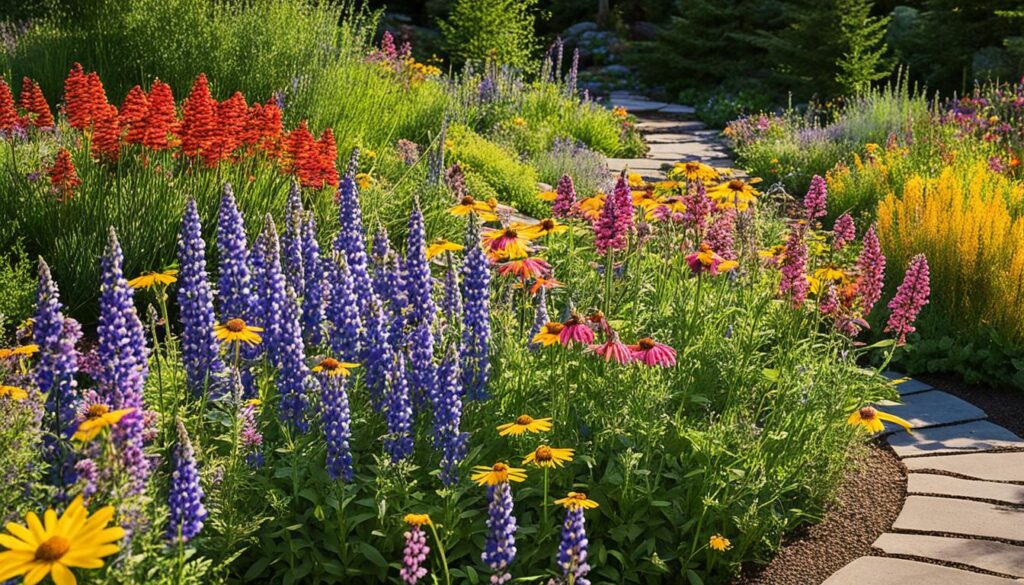
Creating a Balanced Garden
To create a balanced garden, mix different types of perennials based on their bloom time and color. This will ensure a continuous display of colors and prevent any dull patches in your garden. Consider the following table to help guide your selection:
| Season | Recommended Perennial Flowers |
|---|---|
| Spring | Lily-of-the-valley, Bleeding Heart, Iris, Peony |
| Summer | Rose, Coneflower, Daylily, Black-eyed Susan |
| Fall | Sedum, Aster, Goldenrod, Chrysanthemum |
By combining different perennial flower varieties, you can create a dynamic garden that evolves with the changing seasons. This not only enhances the natural beauty of your outdoor space but also provides a habitat for beneficial insects and pollinators.
Early Spring Perennial Flowers for a Colorful Garden Start
Kickstart your garden every spring with a selection of early-blooming perennials. These low-maintenance plants thrive in shady areas and have a low risk of attracting pests. Some popular choices for early spring bloomers include bleeding hearts, candytufts, and astilbes. Their beautiful flowers and foliage will brighten up any shady area of your garden.
These early spring perennial flowers are the perfect way to add a splash of color to your garden as winter fades away. With their vibrant blooms and lush greenery, they will create a stunning display even before the rest of your garden starts to come to life.
One of the advantages of planting early spring perennials is that they often thrive in shady areas of your garden. This makes them ideal for adding color and interest to those underutilized spots. Whether it’s a corner that doesn’t get much sunlight or an area beneath a tree, these perennials will flourish and bring life to those shaded spaces.
In addition to their easy care and shade tolerance, these early bloomers also have the added benefit of attracting less pests. This means that you can enjoy their beauty without the worry of constant pest management. It’s a win-win situation!
Ready to brighten up your shady garden corner with beautiful early spring perennials? These low-maintenance plants will add a pop of color and beauty to your landscape.
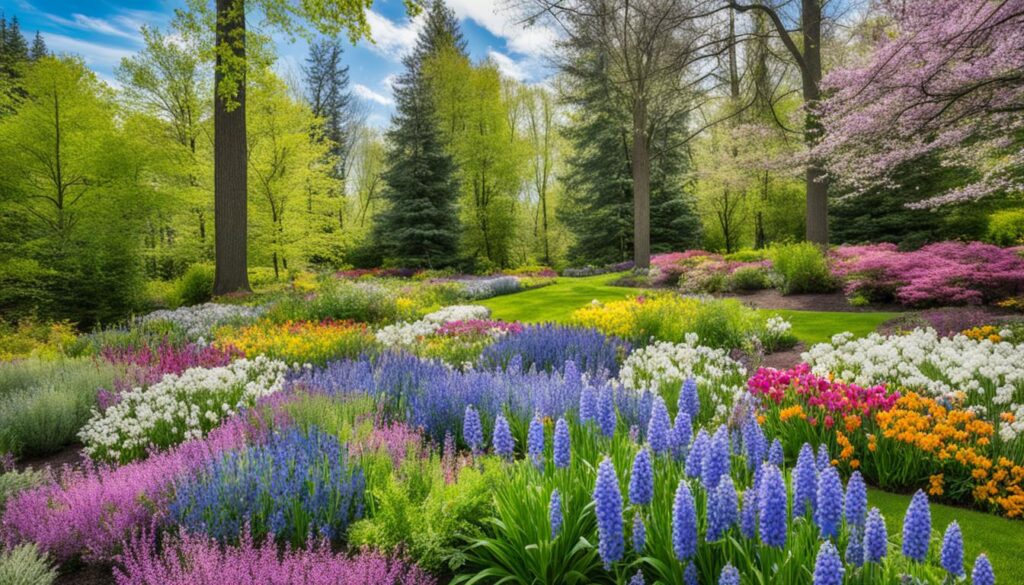
| Perennial Flower | Bloom Time | Height |
|---|---|---|
| Bleeding Hearts | Early spring to early summer | 1-3 feet |
| Candytufts | Early spring | 6-12 inches |
| Astilbes | Late spring to early summer | 1-3 feet |
These early spring perennial flowers offer a range of bloom times and heights, allowing you to create visual interest and variation in your garden. Plant them in clusters or mix them with other spring-blooming perennials for a stunning display.
By incorporating these beauties into your garden, you can start the growing season with a burst of color and enjoy the vibrant blooms before the rest of your perennials start to steal the show.
Summer-Blooming Perennial Flowers for Sun-Loving Gardens
Add a burst of color to your sunny garden with summer-blooming perennials. These beautiful flowers are equipped to withstand the heat and are tough and drought-tolerant. Daylilies, black-eyed Susans, and Russian sage are some popular options for summer bloomers. Their vibrant colors and lush foliage will make your garden a summer paradise.
These summer-blooming perennials are the perfect addition to your perennial flower garden and can withstand the sun’s rays, providing a dazzling display of color throughout the season. These plants are well-suited for sun-loving gardens and require minimal maintenance. With their ability to thrive in hot conditions, they are ideal for areas with long, sunny summers.
Summer-blooming perennials bring life and vibrancy to your garden. Their ability to withstand heat and drought makes them a resilient choice. The bright colors and lush foliage of daylilies, black-eyed Susans, and Russian sage will transform your garden into a mini oasis.
Daylilies, with their trumpet-like flowers, come in a variety of colors and bloom profusely during the summer months. Black-eyed Susans, with their yellow daisy-like flowers, add a touch of cheerfulness to any garden. Russian sage, with its vibrant purple flowers and silver-green foliage, creates a stunning contrast.
These summer-blooming perennials not only provide a visual feast for the eyes but also attract pollinators such as butterflies and bees, making your garden a haven for wildlife.
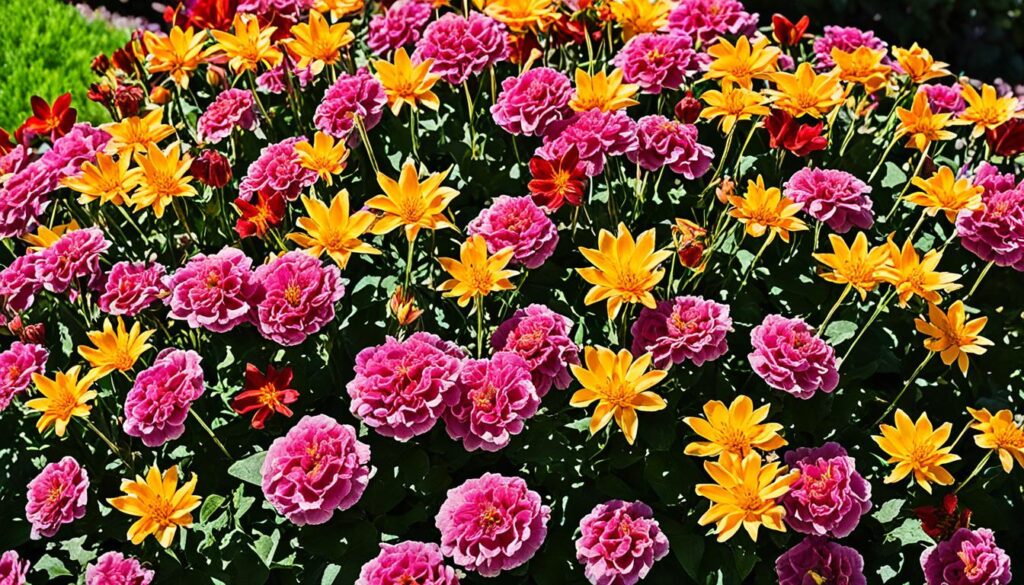
With their ability to thrive in sunny conditions and their captivating colors, these summer-blooming perennials are a must-have for any sun-loving garden. Whether you’re looking to create a focal point, add pops of color, or enhance your existing garden, these plants will not disappoint.
Gardening Tips:
- Provide well-drained soil: Summer-blooming perennials prefer soil that allows excess water to drain away.
- Water regularly: While these plants can tolerate drought, regular watering will help them thrive.
- Prune spent blooms: Removing faded flowers will encourage continuous blooming and maintain the plant’s appearance.
- Fertilize as needed: Use a balanced fertilizer to provide necessary nutrients for healthy growth.
With their resilience and beauty, summer-blooming perennials are a fantastic addition to any garden. Their ability to withstand the summer heat while still providing a burst of color makes them a valuable asset in your perennial flower garden. So, get ready to transform your sunny garden into a stunning summer paradise with these gorgeous perennial flowers.
Shade-Loving Perennial Flowers for a Cool Corner Spot
Create a cool and relaxing corner in your garden with shade-loving perennial flowers. These plants thrive in low-light conditions and provide exciting accents with their bright colors and lush foliage. Some top choices for shade perennials include hostas, astilbes, and toad lilies. Combine these plants to create a visually stunning shade garden.
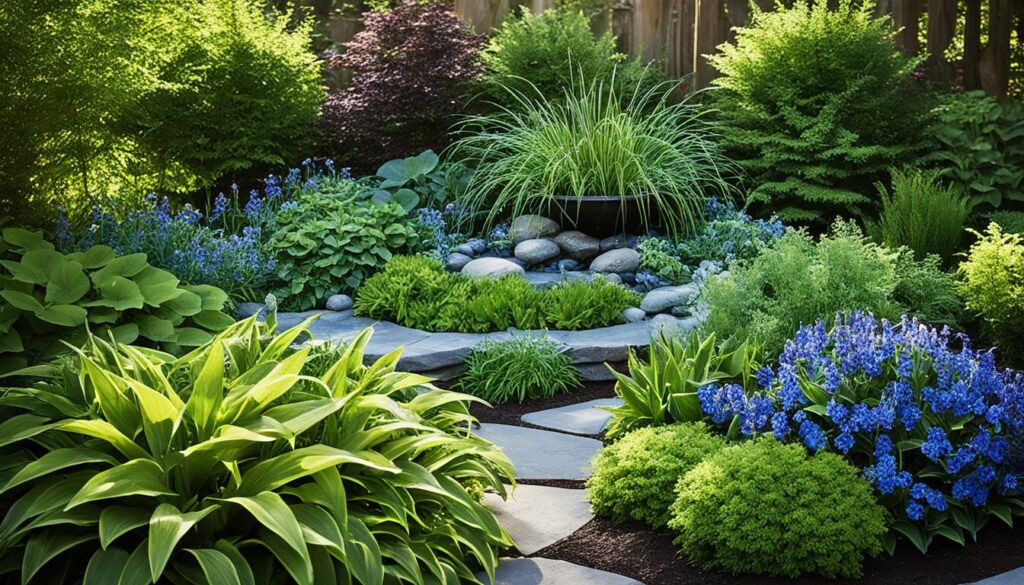
Shade-loving perennial flowers are the perfect addition to any garden, especially if you have a shady area that needs a burst of color. These plants are known for their ability to thrive in low-light conditions, making them a great choice for those difficult spots where other plants struggle.
By incorporating shade-loving perennials into your garden, you can create a cool and relaxing corner that will provide a tranquil escape from the bright sun. These plants not only add beauty to your garden but also provide an oasis for birds and other wildlife.
Hostas are popular shade-loving perennials that come in a variety of sizes and colors. Their large, lush foliage adds a touch of elegance to any garden. Astilbes, on the other hand, are known for their feathery plumes of flowers that come in shades of pink, purple, and white. Toad lilies are unique shade-loving perennials with orchid-like flowers that bloom in late summer and early fall.
When combining these shade-loving perennials, consider their different heights, colors, and textures to create a visually stunning garden. Plant hostas in the background to provide a lush backdrop, and place astilbes and toad lilies in the foreground to create layers of color and interest.
Tips for Planting and Caring for Shade-Loving Perennials:
- Choose a location with dappled sunlight or partial shade for shade-loving perennials.
- Prepare the soil by adding organic matter to improve drainage and fertility.
- Water the plants regularly, keeping the soil moist but not waterlogged.
- Apply a layer of mulch around the plants to help retain moisture and suppress weeds.
- Monitor the plants for any signs of pests or diseases and take appropriate action.
- Divide and replant the shade-loving perennials every few years to ensure their health and vigor.
With these tips in mind, you can create a beautiful and thriving shade garden with shade-loving perennial flowers. Enjoy the cool and serene ambiance they bring to your outdoor space.
Hardy Perennial Flowers for Beating the Summer Heat
As the temperatures rise, it’s important to choose hardy, drought-resistant perennial flowers for your garden. These tough and resilient plants can withstand the scorching summer heat and continue to thrive, bringing vibrant colors to your outdoor space. Here are a few excellent options to consider:
Sedum
Also known as stonecrop, sedums are popular low-maintenance perennials that are perfect for hot, sunny areas. These succulent plants have thick, fleshy leaves that help them retain moisture during dry spells. Sedums come in various colors and forms, ranging from the striking pink flowers of ‘Autumn Joy’ to the yellow blooms of ‘Angelina.’
Catmint
If you’re looking for a perennial flower that can thrive in hot and dry conditions, catmint is a fantastic choice. This low-growing plant produces beautiful spikes of lavender-blue flowers that attract bees and butterflies to your garden. Catmint is known for its aromatic foliage and long bloom time, making it a delightful addition to any perennial flower garden.
Bee Balm
Bee balm, also known as Monarda, is a hardy perennial flower with stunning, vibrant blooms that can tolerate the heat. This plant attracts pollinators, including hummingbirds and butterflies, with its tubular-shaped flowers and aromatic foliage. Bee balm comes in different colors, such as red, purple, and pink, adding a pop of color to your garden.
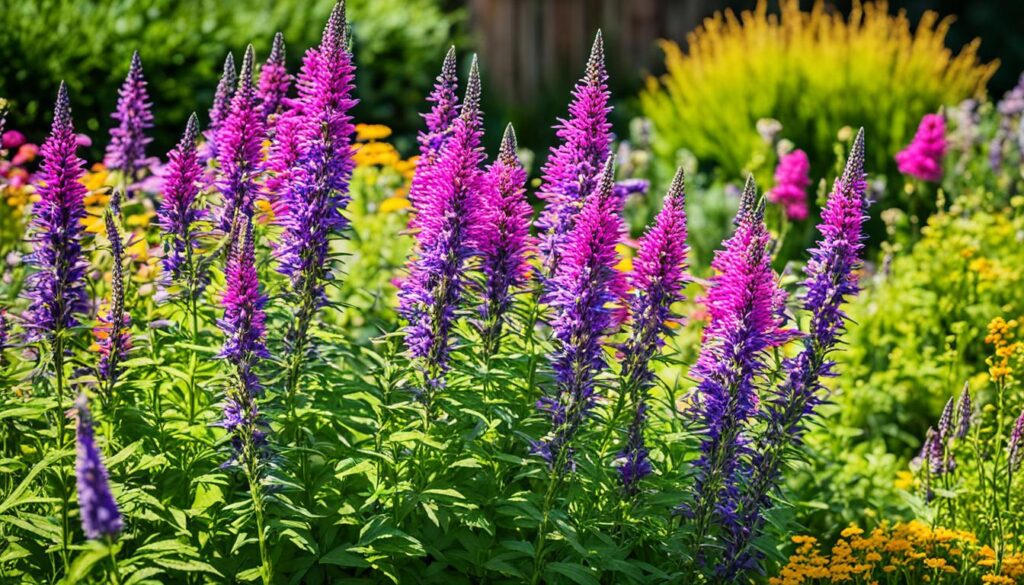
These hardy perennial flowers are excellent choices for beating the summer heat in your garden. Their ability to withstand drought and intense sunlight makes them a reliable option for creating a thriving and colorful perennial flower garden. Plant them in well-draining soil and provide occasional watering during long periods of dry weather.
| Perennial Flower | Characteristics |
|---|---|
| Sedum | Drought-resistant, succulent leaves, various colors |
| Catmint | Tolerates heat and dry conditions, aromatic foliage |
| Bee Balm | Attracts pollinators, vibrant blooms, aromatic foliage |
These hardy perennials will not only survive the summer heat but also add beauty and vibrancy to your garden. With their low-maintenance nature, they are ideal for busy gardeners who want a stunning display without constant monitoring and care. So, beat the summer heat by including these hardy perennial flowers in your garden!
Fall-Blooming Perennial Flowers for Extending the Blooming Season
As summer comes to an end and fall approaches, it’s time to introduce fall-blooming perennial flowers to your garden. These plants will help you enjoy a few last blooms as the leaves start to change. Some popular choices for fall flowers include sedum, asters, and toad lilies.
These perennials will add vibrant colors to your garden and complement the fall season. With their stunning blooms and foliage, they create a beautiful contrast against the changing colors of nature. By incorporating fall-blooming perennials into your garden, you can extend the blooming season and continue to enjoy the beauty of nature even as summer fades away.
Here are some popular fall-blooming perennial flowers:
- Sedum – Known for its clusters of small star-shaped flowers, sedum blooms in various shades of pink, purple, and white. It adds a pop of color to your garden and attracts butterflies and bees.
- Asters – Asters feature daisy-like flowers in vibrant shades of purple, pink, blue, and white. These hardy perennials are easy to grow and provide a stunning display late into the fall season.
- Toad Lilies – With their unique spotted petals and elegant form, toad lilies are a favorite among garden enthusiasts. They bloom in shades of purple, white, and pink, and thrive in shady areas of the garden.
By incorporating these fall-blooming perennial flowers into your garden, you can create a visually stunning landscape that transitions beautifully into the autumn season. These flowers not only provide a burst of color but also attract pollinators, ensuring a lively garden until the first frost arrives.
“Fall is the perfect time to infuse your garden with the vibrant colors of fall-blooming perennials. These hardy flowers will extend the blooming season and brighten up your garden as summer fades away.” – Gardening Expert
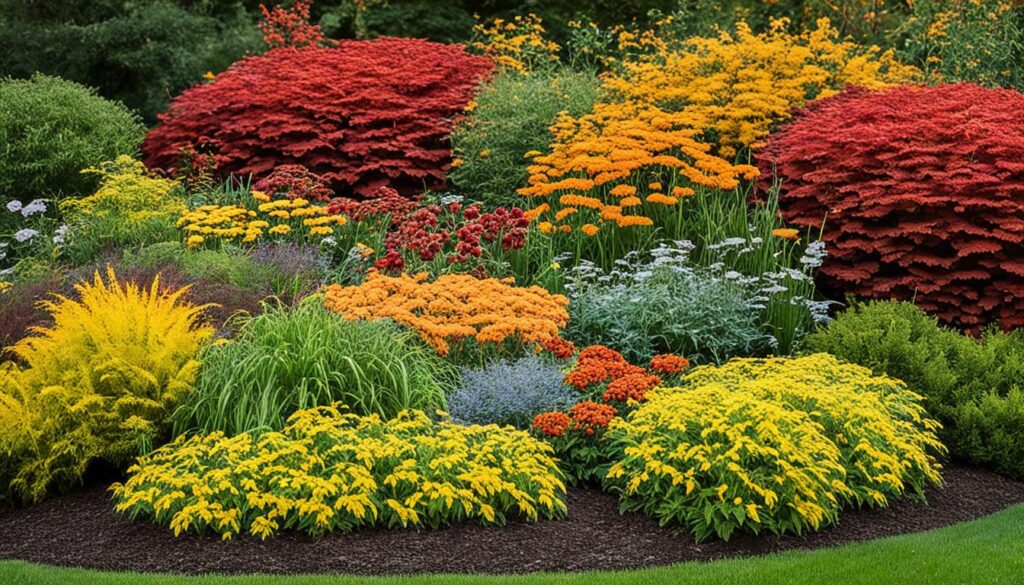
Conclusion
By incorporating a variety of different perennial flowers into your garden, you can enjoy year-round color and beauty. Choose the best perennial flower varieties that suit your preferences and the growing conditions in your area. Whether you opt for vibrant and bold or subtle and elegant flowers, there are numerous options to explore.
Plan your garden for continuous bloom by selecting perennial flowers that bloom at different times throughout the year. Consider the height, size, and bloom time of each plant to create a visually appealing and balanced garden. Incorporate both spring, summer, and fall-blooming perennials to ensure that something is always blooming in your garden.
Maintaining your perennial flower garden is crucial for optimal results. Proper care and attention, such as regular watering, fertilizing, and pruning, will help your plants thrive and continue to produce beautiful blooms. Deadheading spent flowers will promote continuous blooming throughout the season, while mulching will help retain moisture and suppress weed growth.
With the right planning and maintenance, your perennial flower garden will be a source of joy throughout the seasons. So start planning and get ready to brighten your garden with a stunning display of perennial flowers all year long!
FAQ
Why should I choose perennial flowers for my garden?
Perennial flowers are a great addition to any garden because they come back year after year, usually growing stronger and more beautiful with age. Unlike annuals, most perennials have a relatively short bloom season, so planning your garden with plants by season can ensure continuous blooms throughout the year.
How do I choose the right perennial flower varieties for my garden?
When selecting perennial flower varieties, consider factors such as color, bloom time, and growth habit. There are numerous options available, ranging from vibrant and colorful to subtle and elegant. You can also find perennial flower seeds to grow your own, allowing for more variety in your garden. It’s a good idea to choose a mix of different colors to create a visually appealing landscape design.
What should I consider when planting perennial flowers?
Proper care and consideration are important when planting perennial flowers. Create a landscape design that allows for optimal growth and visual appeal by considering factors such as sunlight, soil type, and drainage. Provide adequate spacing between plants to prevent overcrowding, and follow proper planting techniques, such as preparing the soil and watering thoroughly after planting.
How do I maintain perennial flowers for year-round beauty?
Proper maintenance is crucial for perennial flowers. Regular watering, fertilizing, and pruning are essential. Deadheading spent blooms will promote continuous blooming throughout the season. Mulching around the base of the plants can help retain moisture and suppress weed growth. Regularly inspect your plants for any signs of pests or diseases and take appropriate action.
How can I plan my perennial flower garden for continuous bloom?
To achieve continuous bloom in your perennial flower garden, select a combination of spring, summer, and fall-blooming perennials for both sunny and shady areas of your garden. It’s important to choose a variety of colors, heights, sizes, and bloom times to create a balanced and visually appealing garden.
What are some early spring perennial flowers to start off the garden?
Some popular choices for early spring perennials include bleeding hearts, candytufts, and astilbes. These low-maintenance plants thrive in shady areas and have a low risk of attracting pests. Their beautiful flowers and foliage will brighten up any shady corner of your garden.
What are some summer-blooming perennial flowers for sunny gardens?
For a burst of color in your sunny garden, consider daylilies, black-eyed Susans, and Russian sage. These flowers are equipped to withstand the heat and are tough and drought-tolerant. Their vibrant colors and lush foliage will create a summer paradise in your garden.
Can you recommend some shade-loving perennial flowers for a cool corner spot?
If you have a shaded area in your garden, consider planting hostas, astilbes, and toad lilies. These shade-loving perennial flowers thrive in low-light conditions and provide exciting accents with their bright colors and lush foliage.
Are there any hardy perennial flowers that can withstand the summer heat?
Yes, there are numerous hardy, drought-resistant perennial flowers that can withstand the summer heat. Consider planting sedum, catmint, and bee balm. These perennials will bring vibrant colors to your garden while requiring minimal care.
What are some fall-blooming perennial flowers to extend the blooming season?
As summer comes to an end, introduce fall-blooming perennial flowers to your garden. Sedum, asters, and toad lilies are popular choices. These perennials will add vibrant colors to your garden and complement the fall season.
